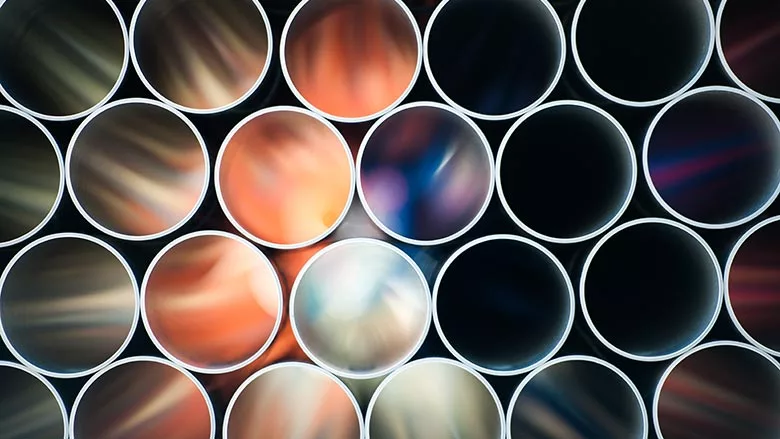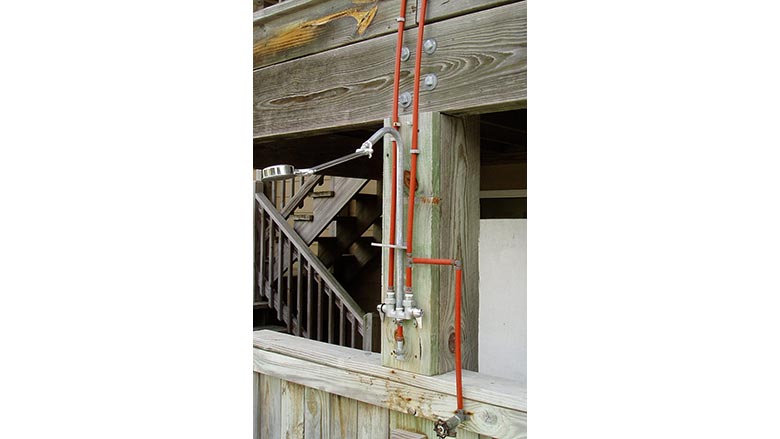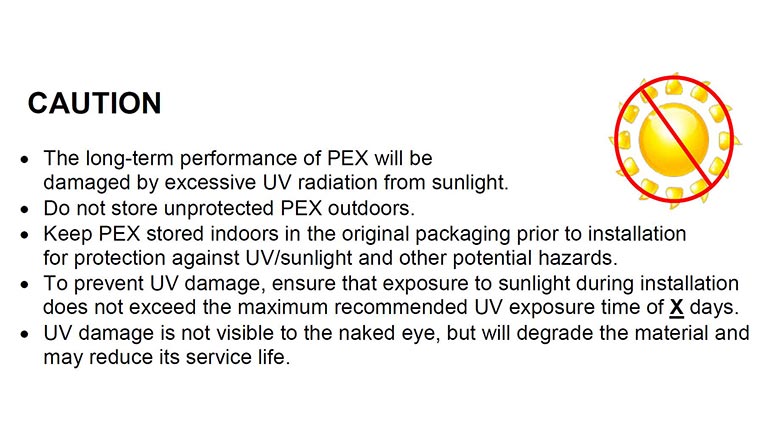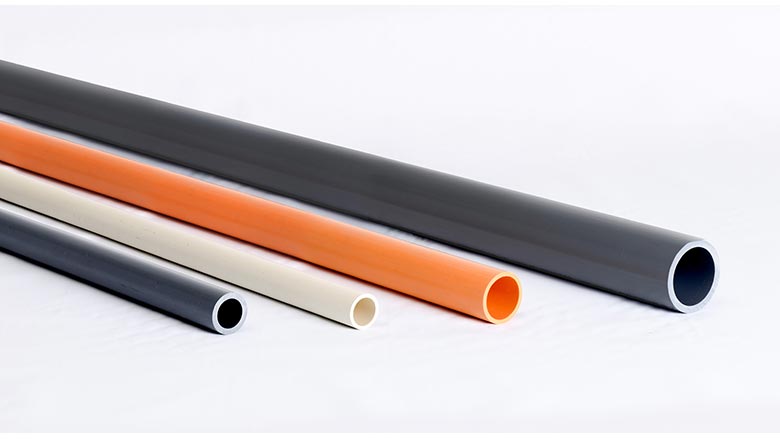Protect CPVC and PEX Pipes from harm
Plastic pipes can have sensitivities to certain environmental exposures.

101cats/iStock/Getty Images Plus via Getty Images.
Over the past 60 years, plastic piping materials have evolved from a new alternative to the material of choice for building and construction applications such as hot- and cold-water plumbing distribution, fire protection and mechanical systems like hydronics and chilled water.
Inherent advantages of plastic materials include safety for drinking water, resistance to corrosion and ease of joining without flame, plus impressive environmental advantages. Plastic piping materials have proven to be extremely reliable and are used in most residential construction. In fact, according to data from the 2020 Home Innovation Research Lab’s Builders Practices Survey, the two most popular pressure piping materials are now PEX and CPVC, being utilized in over 80% of all new residential construction in the U.S.
But did you know that plastic pipes can have sensitivities to certain environmental exposures? There are two issues that may not be as well-known as they should be.

UV resistance — PEX
Many plastics are affected by exposure to direct sunlight and do not have unlimited resistance to ultraviolet (UV) rays from the sun. The family of plastics known as polyolefins, which includes polyethylene (PE), polypropylene (PP) and crosslinked polyethylene (PEX), is sensitive to excessive sunlight and can degrade unless protected. This means that overexposed pipes could become brittle over time and lose their flexibility and then their strength.
Most high-density polyethylene (HDPE) pipes for water and geothermal contain the additive carbon black which provides decades of UV-blocking protection, even when HDPE pipes are installed outdoors. Carbon black is also used in the PE insulation layer in most outdoor wiring.
On the other hand, most PEX products are not black, and are not intended to be installed outdoors. Figure 1 shows a PEX installation for an outdoor shower at a beach house that should not have been allowed, as this tubing may fail prematurely due to sunlight exposure. PEX tubing has somewhat limited resistance to natural sunlight and UV, and this can be different for each product.
Most PEX tubing contains UV inhibitors and/or UV-blocking colorants or coatings to protect it against short-term exposure. PEX is tested for UV resistance according to ASTM Test Method F2657 to prove its UV resistance based on worst-case exposure in the Arizona desert.
PEX manufacturers and industry groups like PPI work hard to inform users of PEX capabilities, including UV resistance. Manufacturers do this through training, labeling and literature. PPI’s Technical Note TN-32 “UV Labelling Guidelines for PEX Tubing and Pipe” provides guidance to manufacturers and users about how to list and interpret UV limits.
Figure 2 is an example of what a UV label can list. The allowed sunlight exposure time is “X days” based on testing of the product according to ASTM F2657. This could be 30 days, 90 days or more. It’s the installer’s responsibility to read labels and protect tubing from overexposure.

The UV resistance of each PEX tubing is also indicated in the tubing print line which is repeated at least every five feet. The four-digit material designation code uses the second digit to indicate the certified UV resistance based on testing according to ASTM F2657 and evaluation, according to ASTM F876.
For example, PEX 1106 has a second digit ‘1’ which means at least 30 days of UV resistance, PEX 3206 has a second digit ‘2’ which means at least 90 days of UV resistance and PEX 5306 has a second digit ‘3’ which means at least six months of UV resistance.
Quality PEX manufacturers integrate sunlight resistance to protect their tubing during installation. Installers should not allow unprotected PEX tubing to sit in the back of a truck or lay around on a jobsite for a lengthy time before installation or to exceed the allowable UV exposure limits for the PEX they are using for any reason.
Chemical resistance — CPVC
For chlorinated polyvinyl chloride (CPVC) piping materials, sunlight is not much of a concern. Instead, users of CPVC pressure pipes need to be aware of the potential chemical damage that can occur when certain construction materials come in contact with CPVC pipe or fittings. The effects of such contact can be slow and gradual but can lead to eventual failure of the piping materials over time.
Lubrizol, the Ohio-based firm that pioneered CPVC piping materials in the 1950s and a major supplier of CPVC compounds to pipe and fitting producers in North America, has done significant research on chemical compatibility issues.
For example, there is an issue that can apply to CPVC pipe or fittings touching flexible plasticized insulation like that on some electrical wire. From Lubrizol’s website, “CPVC is not compatible with some rubber and flexible plastic materials containing certain types of plasticizers. Examples of materials that may contain incompatible plasticizers include, but are not limited to, caulks, rubbery hanger padding, vinyl dip coating on metal parts, rubber gaskets, electrical wire jacketing, electrical tape, flexible hoses or tubes, etc.” If such contact occurs, CPVC pipes can soften or crack over time.
According to Michelle Knight, senior scientist at Lubrizol’s headquarters, “The identification of a chemical as ‘incompatible’ with a plastic is often misunderstood as a guarantee of the eventual failure of the plastic if it is used in contact with the chemical. Actually, chemicals range in effect from ‘always causes failure in every circumstance’ to ‘zero effect in any circumstance.’”
Falling in between these two extremes are most chemicals that might contact the pipe in a typical building installation. In this range, chemicals are capable of having some weakening effect on the plastic, but often not enough to cause failure under most conditions. There must be additional contributions from high mechanical stresses acting on the part at the same time.
Therefore, there are two factors that need to be addressed to minimize the potential for chemically-induced failure. First, contact with potentially incompatible products should be avoided as much as possible by choosing products known to be compatible with CPVC, or by isolating the pipe from questionable products. Second, to minimize the risk from unanticipated chemical contact, mechanical stress should be minimized.

Seldom can one completely predict all the mechanical variables and all the different kinds of chemical substances that will end up inside or on the exterior of a piping system. Therefore, it’s prudent for the piping system designer and installer to do what they can to control the various factors that can contribute to environmental stress cracking.
It’s important that the manufacturer’s installation instructions be consulted regarding the best way to design and install the piping system. These guidelines contain recommendations for proper connection and joining techniques, appropriate piping hangers, placement of supports, thermal expansion compensation, etc. Incorporating these recommendations into the design and construction of the piping system can help minimize extra mechanical stress.
Piping contractors must take steps to protect CPVC pipes from contact with potentially incompatible products on the jobsite. To help installers understand potential compatibility issues and how to avoid them, Lubrizol publishes this information on their website under the heading of FBC System Compatible Program (FBC refers to the piping compounds Flowguard Gold, Blazemaster and Corzan) at www.lubrizol.com/CPVC/FBC-system-compatible-program.
Other chemical compatibilities
Sometimes, finding data about chemical compatibility is a challenge. To assist industry partners, the Plastic Pipe Institute (PPI) has published an online technical report known as PPI TR-19 “Chemical Resistance of Plastic Piping Materials.”
TR-19 provides information about the effects that chemicals can have on plastic piping materials and is available on the PPI website. It applies to pipe and fitting materials shown in Figure 4. It lists the chemical resistance of those plastics to some 600 chemicals, from acetaldehyde to zinc sulfate. This document can be a valuable tool when searching for chemical compatibility of those piping materials.

Of course, pipe users are encouraged to contact manufacturers for assistance, or to reach out to PPI and we’ll help them get the information they need for safe installations.
Looking for a reprint of this article?
From high-res PDFs to custom plaques, order your copy today!




